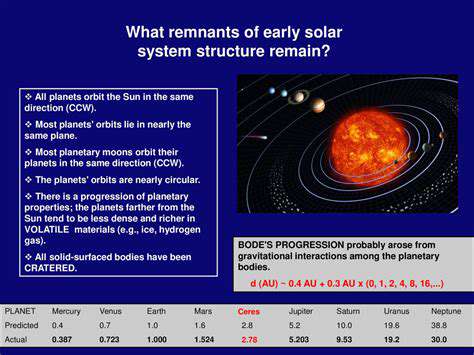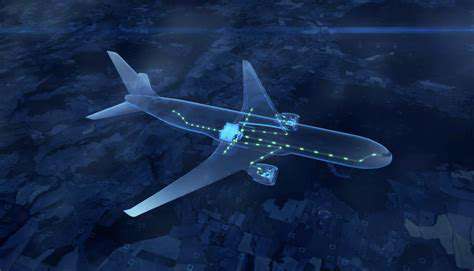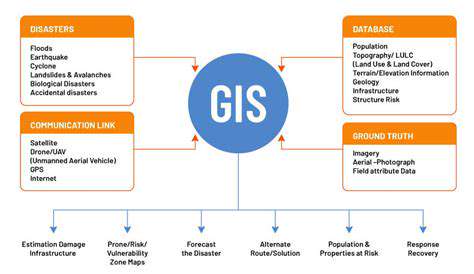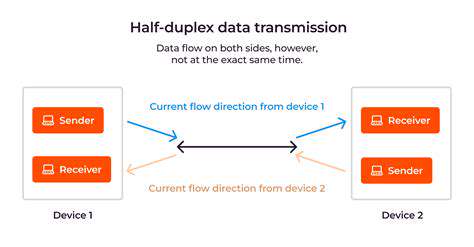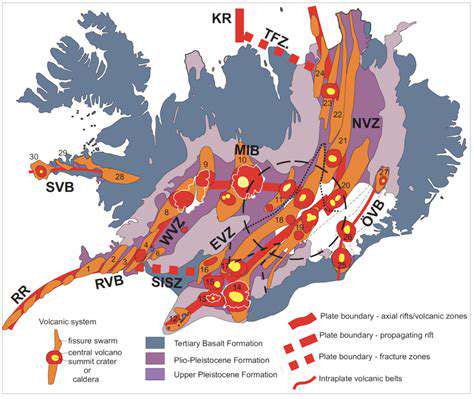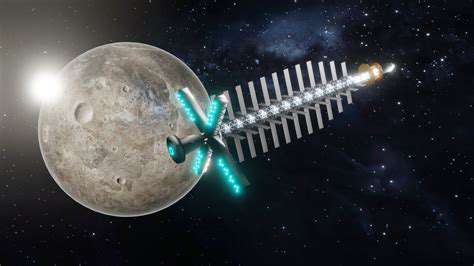Satellite-based hydrology leverages data from Earth-observing satellites to monitor and understand various hydrological processes. This technology offers a unique perspective on the Earth's water cycle, providing critical information for water resource management, flood forecasting, and drought monitoring. Remote sensing capabilities offer a comprehensive view of large areas, surpassing the limitations of traditional ground-based measurements. This global perspective is particularly valuable for studying regional and global water dynamics.
The ability to observe water bodies, snow cover, and land surface characteristics from space provides a wealth of data on water availability and movement. This information is crucial for improving our understanding of water resources and their response to climate change.
Data Sources and Sensors
A variety of satellite sensors, including optical, microwave, and radar systems, are employed to collect data for hydrological studies. Optical sensors, sensitive to reflected sunlight, provide information on vegetation cover, snow cover, and water surface area. Microwave sensors, operating at longer wavelengths, penetrate clouds and offer measurements of surface moisture, soil moisture, and snow depth, even in cloudy conditions.
Each sensor type provides a unique perspective on the hydrological cycle, offering complementary information for a more comprehensive understanding. Radar sensors, for example, are particularly useful for measuring precipitation and surface roughness, adding further depth to the data collected.
Applications in Water Resource Management
Satellite-based hydrological data plays a critical role in supporting water resource management strategies. By providing insights into water availability, flow patterns, and water quality, this data helps in optimizing water allocation, improving reservoir management, and developing efficient irrigation systems. This data-driven approach to water management promotes better use of resources and enhances water security.
Monitoring water levels in reservoirs, assessing river discharge, and identifying areas prone to flooding are key applications that benefit from satellite data.
Flood Forecasting and Early Warning Systems
Rapid and accurate flood forecasting is crucial for minimizing the impact of floods on communities and infrastructure. Satellite data, combined with hydrological models, can be used to detect and track flood events in real-time, providing crucial lead time for early warning systems. Improved flood forecasting can significantly reduce risks and save lives.
The ability to track the movement and extent of floodwaters from space is a vital tool for emergency response and resource allocation.
Drought Monitoring and Assessment
Satellite observations are instrumental in monitoring drought conditions. By assessing changes in soil moisture, vegetation cover, and water levels, satellite data can help identify drought-prone areas and track the progression of drought events. Early detection of drought conditions allows for proactive measures to mitigate its effects, ensuring food security and minimizing economic losses.
The ability to track drought patterns over large areas is essential for informing drought response strategies and allocating resources effectively.
Snowmelt Runoff Modeling
Satellite data on snow cover and snowmelt plays a significant role in understanding and modeling snowmelt runoff. Monitoring snowpack accumulation and melt rates provides crucial input for hydrological models used in forecasting river flow and water availability. Accurate predictions of snowmelt runoff are critical for water resource planning and management, especially in mountainous regions.
By tracking snowpack variations over time, satellite data allows for more accurate predictions of water availability in downstream areas.
Challenges and Future Directions
Despite the significant advantages, satellite-based hydrology faces challenges such as data processing, sensor limitations, and cloud cover. Overcoming these challenges is crucial for maximizing the potential of this technology. Improving data processing techniques, developing more sophisticated algorithms, and leveraging advances in sensor technology are key areas for future research and development.
The integration of satellite data with other sources of hydrological information, such as ground-based measurements and numerical models, will further enhance the accuracy and utility of satellite-based hydrology in the future.
Remote Sensing Techniques for Hydrological Applications
Satellite-Based Data Acquisition for Hydrological Studies
Satellite remote sensing plays a crucial role in hydrological applications, providing a synoptic view of large areas and enabling the monitoring of hydrological processes over time. This data acquisition method offers a unique perspective that is difficult or impossible to achieve through traditional ground-based measurements alone. Satellite-borne instruments capture various electromagnetic spectra, allowing for the estimation of parameters like surface water extent, vegetation cover, and soil moisture, all of which are essential components in hydrological modeling and forecasting. The high spatial and temporal resolution of modern satellite sensors allows for detailed analysis of hydrological phenomena, from localized flood events to large-scale droughts.
The availability of freely accessible satellite data, along with advancements in image processing and analysis techniques, has democratized access to hydrological information. Researchers and water resource managers can now utilize these resources to monitor hydrological systems, assess their vulnerability to climate change impacts, and develop effective strategies for water resource management. This accessibility enables a wider range of stakeholders to contribute to hydrological research and decision-making, leading to more comprehensive and effective solutions.
Hydrological Parameter Estimation from Satellite Imagery
Remote sensing data provides a wealth of information that can be used to estimate crucial hydrological parameters. Techniques like Normalized Difference Vegetation Index (NDVI) calculations can be used to assess vegetation health and productivity, which are strongly linked to evapotranspiration rates. Surface water extent derived from satellite imagery can be used to quantify the volume of water in rivers, lakes, and reservoirs. Soil moisture content, a critical factor in hydrological modeling, can be estimated from microwave sensors, providing insights into the water holding capacity of the soil and its impact on runoff.
Accurate estimation of these parameters is crucial for hydrological modeling and forecasting. Advanced algorithms and machine learning techniques are increasingly being used to improve the accuracy and efficiency of parameter estimation from satellite data. Integration of multiple satellite datasets, including optical and radar data, often enhances the precision of these estimations, leading to more robust and reliable hydrological models.
Applications of Remote Sensing in Hydrological Modeling
Remote sensing data serves as a valuable input for hydrological models, improving their accuracy and predictive capabilities. By incorporating satellite-derived parameters into models, we can refine our understanding of hydrological processes and enhance the reliability of future predictions. For example, incorporating satellite-based soil moisture data into hydrological models can significantly improve the simulation of runoff and groundwater recharge processes.
Applications span a wide range of hydrological issues, from flood forecasting and drought monitoring to water resources management. The integration of satellite data can provide a more comprehensive understanding of the hydrological cycle in specific regions, enabling the development of more targeted and effective management strategies. By providing a broader perspective and encompassing larger areas, satellite data allows for a more holistic approach to hydrological research and management.
Challenges and Future Directions in Satellite-Based Hydrological Applications
Despite the numerous advantages, several challenges remain in utilizing remote sensing for hydrological applications. Cloud cover, atmospheric conditions, and sensor limitations can affect data quality and accuracy. Improving data processing and analysis techniques to address these challenges is essential for achieving more reliable results. Ensuring consistent data acquisition protocols across different satellites and time periods is another critical aspect for long-term hydrological monitoring and analysis. The development of advanced algorithms and machine learning models, coupled with improved data fusion techniques, will further enhance the accuracy and efficiency of remote sensing data in hydrological applications.
Looking ahead, continued advancements in satellite technology and sensor capabilities, along with improved data processing algorithms, hold immense potential for revolutionizing hydrological studies. The integration of remote sensing data with other datasets, such as meteorological data and ground-based observations, will provide a more comprehensive and nuanced understanding of hydrological processes. This integration will ultimately lead to more effective water resource management strategies in the face of a changing climate.
Applications of Satellite Data in Hydrological Modeling
Satellite-Based Data for Improved Precipitation Estimation
Satellite data plays a crucial role in improving the accuracy and spatial coverage of precipitation estimates, a fundamental input for hydrological models. By providing a synoptic view of weather systems across vast areas, satellites can capture precipitation events that might be missed by ground-based networks, particularly in remote or sparsely populated regions. This enhanced coverage allows for the development of more comprehensive hydrological models that better represent the complex spatial and temporal variability of rainfall patterns. The ability to observe precipitation over large areas in near real-time is invaluable for flood forecasting and drought monitoring, enabling timely responses to hydrological hazards.
Different satellite sensors, such as passive microwave and active radar systems, offer varying degrees of sensitivity to different precipitation types. Understanding the strengths and limitations of each sensor is critical in selecting the appropriate data source for a specific hydrological application. For instance, passive microwave sensors are often better at detecting light rainfall and snowfall, while radar sensors provide higher resolution information about the intensity and location of precipitation. Combining data from multiple satellite sensors can enhance the overall accuracy and reliability of precipitation estimates, creating a more robust dataset for model input.
Satellite-Derived Variables for Enhanced Model Calibration and Validation
Beyond precipitation, satellite data provides valuable information on other key hydrological variables. For example, satellite-derived surface water extent and soil moisture content are critical for calibrating and validating hydrological models. Monitoring surface water bodies like lakes, reservoirs, and rivers enables a more accurate representation of water storage changes, a crucial aspect of hydrological modeling. The dynamic response of surface water to rainfall events and seasonal changes can be effectively tracked using satellite imagery, providing valuable insights for model calibration and validation.
Soil moisture, another crucial variable, is often challenging to measure directly over large areas. Satellite sensors, however, can provide estimates of soil moisture content, enabling hydrological models to account for the interaction between water and the land surface. This improved representation of soil moisture dynamics leads to a more comprehensive understanding of hydrological processes, particularly in regions with varying soil types and vegetation cover. This data is essential for improving model predictions of runoff, infiltration, and evapotranspiration, ultimately leading to more accurate projections of water availability.
Moreover, satellite data can be utilized to determine land cover and vegetation characteristics, which are essential for estimating evapotranspiration. This process, driven by solar radiation and plant activity, significantly influences hydrological cycles. The inclusion of these variables in hydrological models improves the accuracy of water balance calculations and the overall predictive capabilities of the models. In essence, satellite-derived data provides a holistic view of the hydrological system, allowing for a more sophisticated and accurate representation in models.
Properly cleaning and seasoning your cast iron skillet is crucial for achieving optimal cooking results and extending its lifespan. Begin by preheating your oven to 400 degrees Fahrenheit. Then, carefully scrub the skillet with hot, soapy water and a stiff brush, removing any food residue. Rinse thoroughly and dry completely. Next, apply a thin layer of cooking oil, such as canola or vegetable oil, to the entire surface of the skillet. Place the skillet in the preheated oven and bake for 30 minutes. Remove the skillet and allow it to cool completely. This initial seasoning process creates a protective, non-stick surface that will enhance the flavor of your meals.
Monitoring Water Stress and Droughts with Satellites
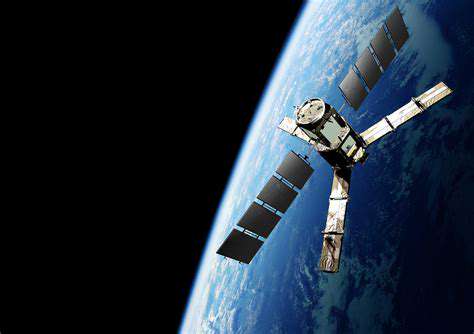
Understanding Water Stress
Water stress in plants occurs when the plant's need for water exceeds the available water supply. This can manifest in various ways, from subtle wilting to complete cessation of growth. Understanding the specific indicators of water stress is crucial for effective intervention and preventing significant crop losses. Recognizing the early signs allows for timely irrigation and management strategies to maintain optimal plant health.
Several factors contribute to water stress, including drought conditions, insufficient irrigation, or poor soil drainage. Each of these factors can impact the plant's ability to absorb and utilize water, leading to a cascade of physiological changes that ultimately affect yield and quality.
Monitoring Drought Conditions
Drought conditions are characterized by a prolonged period of low precipitation, resulting in a significant depletion of soil moisture. This prolonged dryness significantly reduces the water available to plants, leading to stress and potential damage. Effectively monitoring drought conditions requires a combination of weather data, soil moisture sensors, and visual observations of plant health.
Historical weather patterns, current precipitation levels, and projected forecasts are all critical data points for predicting and assessing the severity of drought. This information is vital for developing proactive irrigation strategies and making informed decisions about crop management.
Methods for Assessing Water Stress
A variety of techniques can be utilized to assess the level of water stress in plants. These methods range from simple visual inspections to more sophisticated techniques that measure physiological responses. Visual observations, such as leaf wilting, color changes, and stem turgor, can provide initial indications of water stress. However, these visual cues can be subjective and may not always reflect the underlying physiological conditions.
More advanced methods, such as measuring leaf water potential or using sensors to monitor soil moisture, offer a more precise assessment of plant water status. These methods provide valuable data for implementing targeted irrigation interventions and optimizing water use efficiency.
Impact of Water Stress on Crop Yields
Water stress significantly impacts crop yields by affecting various physiological processes within the plant. Reduced water availability can lead to decreased photosynthesis, hindered nutrient uptake, and compromised reproductive development. These cascading effects ultimately result in lower yields and reduced crop quality. Understanding these impacts is essential for developing strategies to mitigate the negative consequences of water stress.
The severity of yield reductions depends on the intensity and duration of water stress, as well as the specific crop type. Certain crops are more susceptible to water stress than others, necessitating tailored management practices to ensure optimal water use and yield.
Managing Water Stress and Drought
Effective strategies for managing water stress and drought involve a combination of proactive and reactive approaches. Proactive measures include optimizing irrigation schedules, selecting drought-tolerant crop varieties, and implementing soil conservation practices. These proactive steps help to minimize the negative impacts of water stress on crop yields and overall agricultural productivity.
Reactive strategies focus on promptly addressing water stress once it is detected. This often involves implementing emergency irrigation measures, adjusting fertilization schedules, and potentially altering planting dates to minimize the duration of stress periods.


